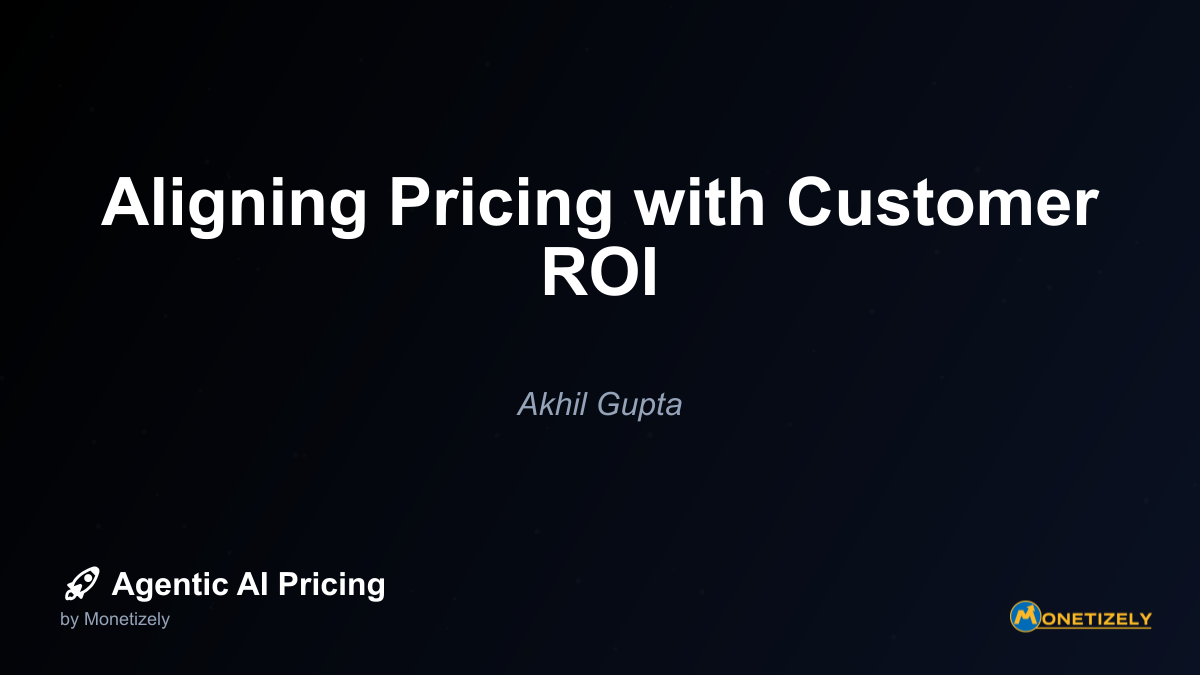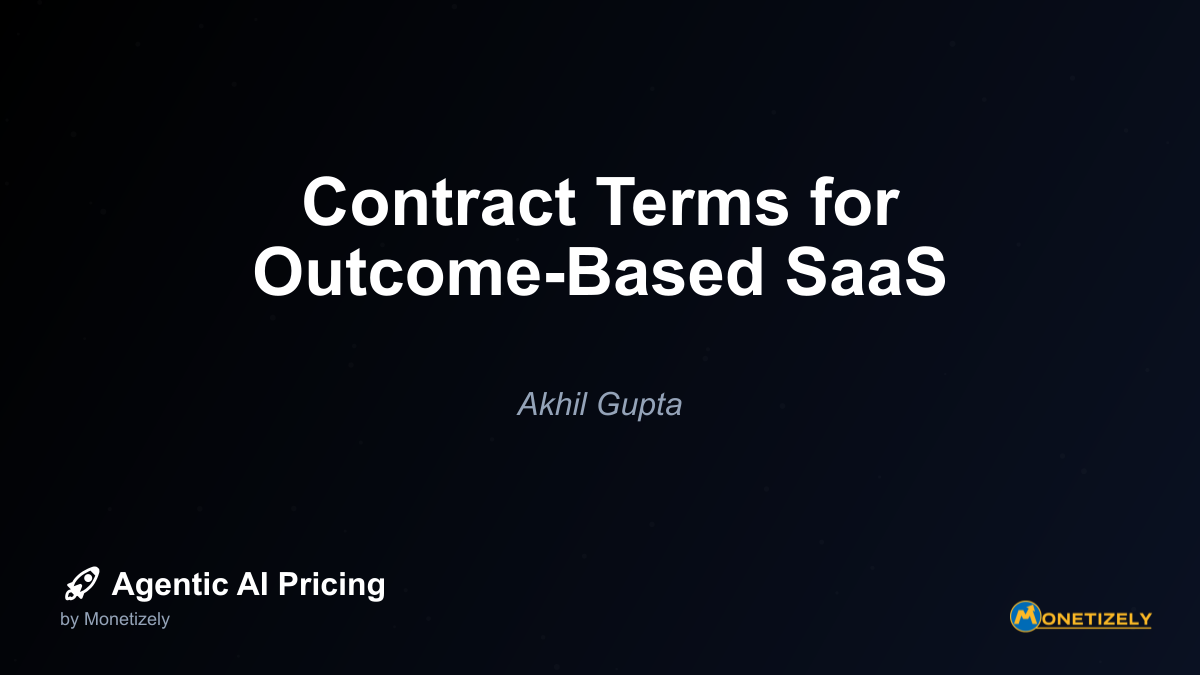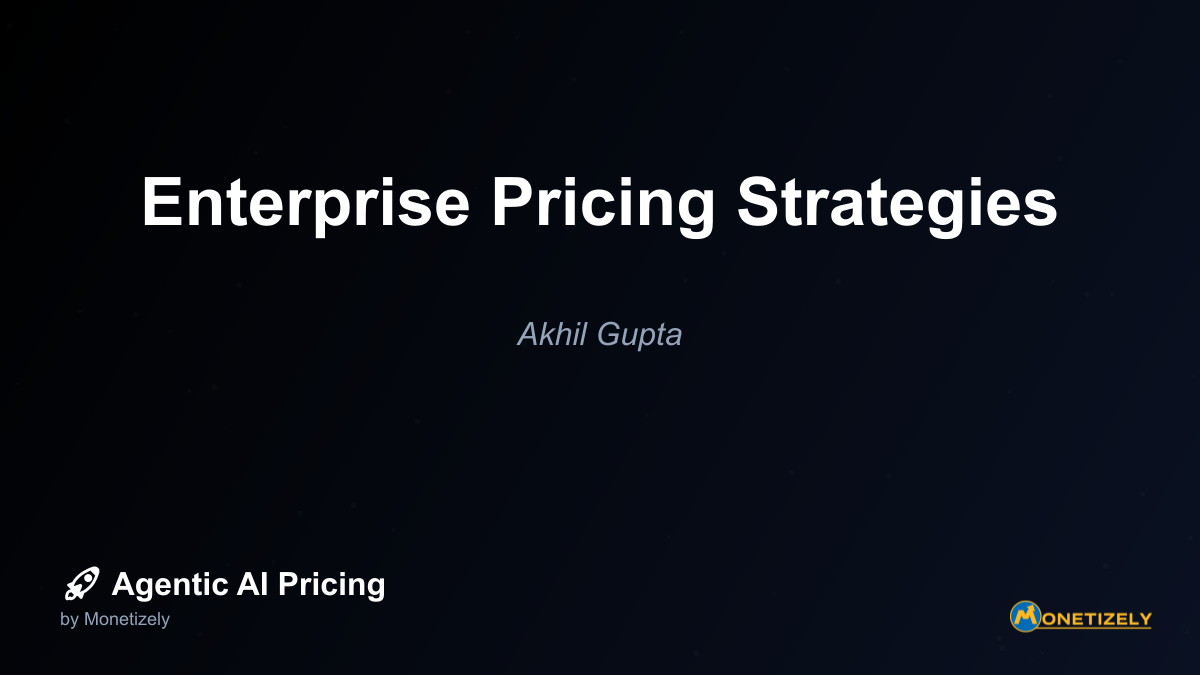· Akhil Gupta · Pricing Agentic SaaS Products · 8 min read
Discounting Strategies for Agentic SaaS
AI and SaaS Pricing Masterclass
Learn the art of strategic pricing directly from industry experts. Our comprehensive course provides frameworks and methodologies for optimizing your pricing strategy in the evolving AI landscape. Earn a professional certification that can be imported directly to your LinkedIn profile.

Implementing Discount Guardrails for Agentic AI Products
While strategic discounting can accelerate growth, unmanaged discounting can quickly erode your margin structure. For agentic AI products, implementing strict guardrails is even more critical than for traditional SaaS.
The “Agentic Floor Price” Concept
For each agentic capability, establish an absolute floor price based on:
- Direct compute costs: The baseline infrastructure expense to deliver the capability
- Indirect operational costs: Support, maintenance, and improvement costs
- Value floor: The minimum monetizable value delivered to customers
- Market positioning threshold: Price points below which brand perception suffers
This floor price should be non-negotiable across your organization, preventing even the most aggressive sales representatives from compromising long-term viability for short-term wins.
Leading organizations implement robust discount guardrails that prevent price erosion while maintaining sales flexibility—a practice even more critical for agentic AI products with their complex cost structures.
Creating a Discount Authority Matrix
For agentic products, traditional approval hierarchies often prove insufficient. Instead, implement a multi-dimensional authority matrix that considers:
- Deal size: Larger deals may warrant deeper discounts due to economies of scale
- Strategic value: High-visibility customers may justify special pricing
- Feature utilization: Discount authority varies based on which agentic capabilities are included
- Margin impact: Discount authority decreases as margin thresholds are approached
- Term commitment: Longer commitments enable greater flexibility
Sample Discount Authority Matrix for Agentic Products:
| Deal Size | Standard Features | High-Compute Features | Strategic Account | Standard Account |
|---|---|---|---|---|
| < $10K | Up to 10% (Sales) | Up to 5% (Sales) | Up to 15% (Sales) | Up to 10% (Sales) |
| $10K-$50K | Up to 15% (Sales) | Up to 10% (Sales) | Up to 20% (Manager) | Up to 15% (Manager) |
| $50K-$100K | Up to 20% (Manager) | Up to 15% (Manager) | Up to 25% (Director) | Up to 20% (Director) |
| > $100K | Up to 25% (Director) | Up to 20% (Director) | Up to 30% (VP) | Up to 25% (VP) |
Discount Documentation Requirements
For each discount exceeding 10% of list price, require formal documentation that includes:
- Strategic justification: Why this discount aligns with company objectives
- Competitive analysis: Market context necessitating the discount
- Value alignment: How the discounted price still reflects delivered value
- Precedent implications: Assessment of how this discount might affect future deals
- Margin impact analysis: Quantification of financial implications
This documentation serves multiple purposes: it creates accountability, provides data for future pricing decisions, and ensures thoughtful consideration rather than reflexive discounting.
Timing-Based Discount Strategies for Agentic AI
The temporal dimension of discounting is particularly important for agentic products, which often improve rapidly over time.
1. Introductory Period Discounts
These limited-time discounts acknowledge that early adopters of agentic capabilities may experience a product still evolving to its full potential.
Implementation approach:
- Clearly define the introductory period (typically 3-6 months)
- Communicate the standard pricing that will apply afterward
- Provide transparent criteria for potential extensions
- Offer smooth transition options if needed
Example: An agentic content creation platform might offer a 40% discount for the first three months, reducing to 20% for months 4-6, before transitioning to standard pricing—acknowledging that the AI’s quality improves with usage and training.
2. Capability Maturity Pricing
This sophisticated approach ties pricing to the evolution of specific agentic capabilities over time.
Implementation approach:
- Define measurable maturity indicators for each capability
- Create a pricing schedule that increases as capabilities mature
- Implement objective measurement methodologies
- Communicate the maturity roadmap transparently
Example: An agentic process automation platform might price its document processing capability at a 30% discount initially, with scheduled price increases as accuracy milestones are achieved (e.g., 85%, 90%, 95% accuracy).
3. Usage Ramp Discounting
This approach acknowledges that organizations need time to fully integrate agentic capabilities into their workflows.
Implementation approach:
- Design discount tiers that decrease as usage increases
- Define clear usage measurement criteria
- Create predictable transition points
- Provide usage visibility tools to customers
Example: An agentic data analysis platform might offer a 35% discount when processing fewer than 1,000 reports monthly, 25% for 1,000-5,000 reports, and 15% for 5,000-10,000 reports, encouraging expanded adoption while preserving margins at scale.
Segment-Specific Discounting for Agentic AI Products
Different customer segments interact with agentic capabilities in distinct ways, warranting tailored discounting approaches.
1. Industry-Specific Discount Programs
These programs acknowledge that agentic AI delivers different value profiles across industries.
Implementation approach:
- Identify high-potential vertical markets
- Quantify industry-specific value creation
- Design discount programs that reflect industry economics
- Create industry-specific success stories
Example: An agentic legal document analysis platform might offer deeper discounts to non-profit organizations (25-30%) compared to law firms (10-15%), reflecting different economic models while maintaining profitability across segments.
2. Adoption Stage Discounting
This approach recognizes that organizations at different stages of AI adoption require different incentives.
Implementation approach:
- Define clear adoption stage criteria
- Create discount tiers aligned with adoption readiness
- Design transition paths between stages
- Provide adoption acceleration resources
Example: An agentic customer intelligence platform might offer “AI explorer” discounts (30%) for organizations just beginning their AI journey, “AI adopter” discounts (20%) for those with some experience, and “AI advanced” discounts (10%) for sophisticated users.
3. Competitive Displacement Offers
These targeted discounts aim to overcome switching costs for customers using competing solutions.
Implementation approach:
- Identify key competitors and their pricing models
- Calculate typical switching costs
- Design time-limited displacement offers
- Create migration support packages
Example: An agentic sales intelligence platform might offer a 40% first-year discount specifically for customers switching from legacy, non-AI platforms, covering the transition period while ensuring long-term profitability.
Measuring Discount Effectiveness for Agentic Products
For agentic AI offerings, traditional discount ROI calculations often fall short. Instead, implement these specialized measurement frameworks:
1. Capability Adoption Velocity
Track how quickly discounted customers adopt the full range of your agentic capabilities compared to non-discounted customers.
Key metrics:
- Time to first use of advanced features
- Breadth of capability utilization
- Depth of integration with customer workflows
- User expansion within customer organization
2. Value Realization Timelines
Measure how discounting affects the speed at which customers achieve measurable value from your agentic capabilities.
Key metrics:
- Time to first value milestone
- Acceleration of value delivery timeline
- Customer-reported ROI timelines
- Value expansion over time
3. Long-Term Margin Impact
Look beyond immediate discount costs to understand the true economic impact over the customer lifecycle.
Key metrics:
- Discount amortization period
- Margin recovery timelines
- Expansion revenue margin profiles
- Total customer lifetime value
4. Competitive Position Reinforcement
Assess how discounting affects your market position relative to both AI and non-AI alternatives.
Key metrics:
- Win rate changes against different competitor types
- Competitive displacement success rates
- Market perception shifts
- Analyst positioning improvements
Common Discounting Pitfalls for Agentic AI Products
Even well-designed discount strategies can fail in execution. Here are the most common pitfalls specific to agentic products:
1. Discounting Core Intelligence Instead of Applications
Many companies mistakenly discount their fundamental AI capabilities rather than specific applications of those capabilities.
Solution: Structure your pricing so that core intelligence maintains its value integrity, while specific applications or use cases can be selectively discounted.
2. Ignoring Compute Cost Variations
Agentic features often have dramatically different cost profiles, but many companies apply uniform discounts across their product.
Solution: Align discount availability with the cost structure of specific capabilities, limiting discounts on high-compute features.
3. Failing to Account for Rapid Improvement
Agentic products typically improve faster than traditional software, making long-term discounts particularly risky.
Solution: Implement time-bounded discounts with clear transition paths to standard pricing as capabilities mature.
Enterprise customers often expect significant discounts, but with agentic AI, these expectations must be managed against the reality of higher delivery costs and ongoing R&D investments.
4. Disconnecting Discounts from Value Metrics
Many agentic AI companies discount based on traditional SaaS metrics rather than aligning with their unique value delivery.
Solution: Tie discount structures directly to the value metrics most relevant to your agentic capabilities.
5. Overlooking Ecosystem Effects
Agentic AI often delivers value through ecosystem connections, which can be undermined by inconsistent discounting.
Solution: Create holistic discount programs that consider the entire customer ecosystem rather than isolated product components.
Communicating Discounts Effectively for Agentic Products
The way you frame and communicate discounts significantly impacts their effectiveness and your brand perception. For agentic products, consider these specialized approaches:
1. Value-First Framing
Always lead with value before introducing the discount, establishing the full worth of your agentic capabilities.
Example language: “Our document intelligence platform delivers an average 73% reduction in processing time, valued at $450,000 annually for organizations your size. Through our Early Adopter Program, we’re offering a 25% reduction for the first year to selected innovation partners.”
2. Investment Narrative
Position discounts as investments in mutual success rather than price reductions.
Example language: “We’re investing $75,000 in your success through our onboarding acceleration program, reducing first-year costs while our teams collaborate to maximize your ROI.”
3. Capability Growth Storytelling
Frame discounts within the narrative of evolving capabilities.
Example language: “As our language generation capabilities expand from the current 87% accuracy to our targeted 95% over the next six months, we’re offering scaled pricing that grows with our performance.”
4. Exclusivity Emphasis
Position discounts as selective opportunities rather than generally available reductions.
Example language: “Based on your industry leadership and innovation profile, we’ve selected your organization for our Strategic Innovation Partner program, which includes preferred pricing on our advanced agentic capabilities.”
Conclusion: Building a Sustainable Discount Strategy for Agentic AI
Discounting agentic AI products effectively requires a fundamental rethinking of traditional SaaS approaches. The unique cost structures, rapid evolution, and value delivery mechanisms of agentic products demand more sophisticated, strategic discount frameworks.
The most successful companies in this space follow these core principles:
Align discounts with cost realities: Structure discounts to protect margins on high-compute, high-cost capabilities.
Time-bound your commitments: Limit discount durations to account for the rapid evolution of agentic capabilities.
Connect discounts to value delivery: Tie discount structures directly to measurable customer outcomes.
Implement strict governance: Create robust guardrails that prevent margin erosion while maintaining sales flexibility.
Measure holistically: Look beyond short-term revenue impacts to understand the full lifecycle effects of your discount programs.
By approaching discounting strategically rather than reactively, you can accelerate adoption of your agentic AI offerings while building a sustainable, profitable business model. The companies that master this balance will ultimately define the economics of the agentic AI industry for years to come.
Remember that in the rapidly evolving agentic AI landscape, your pricing and discounting strategies are not just tactical decisions but strategic positioning statements that will significantly impact your company’s long-term trajectory.
Co-Founder & COO
Akhil is an Engineering leader with over 16+ years of experience in building, managing and scaling web-scale, high throughput enterprise applications and teams. He has worked with and led technology teams at FabAlley, BuildSupply and Healthians. He is a graduate from Delhi College of Engineering and UC Berkeley certified CTO.
Pricing Strategy Audit
Let our experts analyze your current pricing strategy and identify opportunities for improvement. Our data-driven assessment will help you unlock untapped revenue potential and optimize your AI pricing approach.




